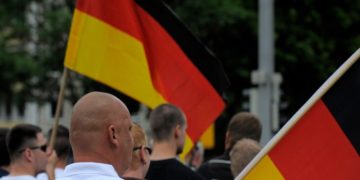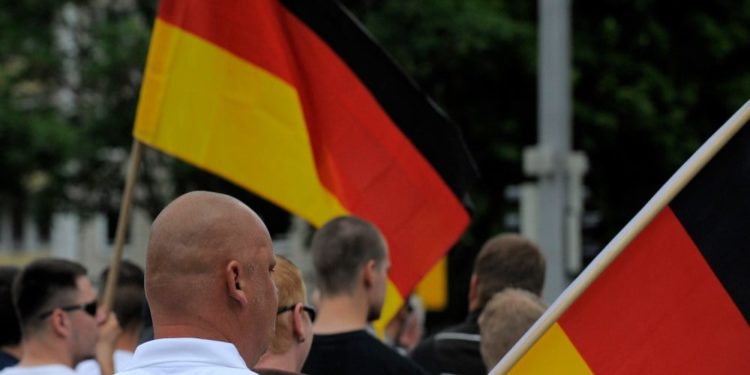The Sept. 1 elections in the two eastern German states of Saxony and Thuringia have hit Germany like a cyclone, delivering the strongest-ever turnout for an extreme right-wing party in the postwar era. In Saxony, the hard-right Alternative for Germany (AfD) captured 31 percent, landing it narrowly behind the Christian Democrats (CDU), and in Thuringia, where the AfD is led by a twice-court-fined ideologue and outspoken neo-fascist named Björn Höcke, the party took 33 percent of the vote, the highest of any party, and thus also the mandate to form a government. The new populist party Sahra Wagenknecht Alliance (BSW)—a rightist offshoot of the Left Party that boasts anti-immigration planks and pro-Russian sympathies—landed in third place in both states.
Although it is unlikely that another party will partner up with the AfD in governance—they all say they refuse to do so—the results raise resounding questions for modern Germany. How can such an extreme hard-right party perform so well in postwar Germany, a country that, in both its eastern and western postwar incarnations, made preventing the return of a racist, authoritarian leadership its very raison d’être? Why is this phenomenon so pronounced and radical in the country’s east, the territory of former communist East Germany, almost 35 years after the Berlin Wall fell?
Germans are now asking: How could everything go so wrong? Several recently published books by German authors offer a reckoning—and some answers.
Proponents of eastern Germany, including literature scholar Dirk Oschmann and historian Katja Hoyer, authors of recent bestsellers blasting the overbearing West and those taking the West’s side—most of the mainstream media, including the leading weekly news magazine Der Spiegel—are practiced at lobbing rhetorical grenades at one another. On their own, these one-sided arguments miss the mark. But taken together, and combined with new material, they explain how the Germanies’ journey wound up such a wreck.
The cleft between eastern and western Germany—defined by the East’s extreme-right vote and preponderance of street violence, as well as the inability of the republic’s mainstream parties (with the exception of the CDU) to attract eastern members and votes—can be traced to the events following the fall of the Berlin Wall. Today’s hard-right sympathies in the East are largely, though not exclusively, spiteful backlash against the one-sided terms of West Germany’s annexation of the East, the West’s demeaning treatment of the easterners, the indignity that the economic transition inflicted on many eastern Germans, and the legacy of a suffocating, repressive dictatorship on its former subjects and their successor generations.
Detlev Claussen, an emeritus sociologist from Frankfurt, hit the nail on the head: “The AfD is the East’s revenge on the West, which is blamed for all the upheavals after 1990,” he wrote in an email to Foreign Policy. “The party’s personnel are right-wing extremists, the electorate only partly so, although it too appears indifferent to the accusation of Nazism.” Claussen pointed out that populists’ top issues were migration and the Ukraine war, two topics that are not relevant to regional governance. Rather, another topic is almost always predominant behind them, one regularly laced into the rhetoric of both the AfD and BSW: the unfair, demeaning terms of unification and the terms of the transformation since then. “The essence of the far-right vote is resentment against the West,” Claussen wrote.
The AfD vote in the East is complex: The five eastern states aren’t a seething bastion of foaming-at-the-mouth neo-Nazis—although neo-Nazis are among them. German studies show that about 8 percent of Germans—on both sides of the country—firmly subscribe to hard-right, racist ideological worldviews with a large additional segment in a gray zone that might well sometimes—but not always—support the likes of a right-wing dictatorship, street violence against politicos, racist laws, and antisemitism, too.
The numbers aren’t that much different than in other European countries, though they are in Germany currently higher than at any time since the Nazi era, particularly among young people, and also higher in eastern Germany than western Germany. About half of AfD supporters in the East—roughly 15 percent of the voting population—are rightists hardcore enough to actually lionize—rather than just accept—Höcke, who employs thinly veiled neo-Nazi language, soft-pedals Germany’s World War II crimes, and wants to “remigrate” non-native Germans living in Germany to their origin countries.
This radical segment is extremely alarming and constitutes a menace for people of color, LGBTQ+ individuals, Muslims, and leftist groupings, among others. They are the types who either perpetrate or condone far-right hate crimes, which have been on the rise for several years. Germany’s security services counted 25,660 such incidents in 2023. That’s an average of 70 a day Germany-wide and 22 percent more than in 2022. In May, a candidate for the Social Democrats was attacked and badly injured in Dresden, capital of Saxony, when pasting up EU election campaign posters. Experts say that this kind of violence hasn’t been so vicious since the 1990s, tagged today as “the baseball-bat years,” when pogrom-like attacks were carried out in the eastern states against migrants and others.
The 1990s is a good place to start to understand right-wing extremism in the East. The easterners had emerged from beneath the heavy hand of Soviet communism and were pleased to be rid of it, as well as welcoming to political and economic systems—liberal democracy and market capitalism—that they knew very little about. They were also unaware of how thoroughly the decades of authoritarian, militaristic education and indoctrination had penetrated their psyches and habits. East German communism was ethnically homogeneous and nothing if not narrow-minded; the very few non-Germans living in East Germany, such as African or Asian guest workers, reported regular abuse. When the wall fell, West German rightists—a generation before Höcke, who himself was born and raised in northwestern Germany—poured into the East to tap this raw energy and organize. When the easterners were confronted with refugee hostels in their communities in the 1990s, they often reacted with anger—and baseball bats.
One explanation of the racist violence and voting patterns today in the East lies in the 1949 to 1990 German Democratic Republic, and the values passed on from generation to generation. The young people today voting AfD and belonging to neo-Nazi street gangs are the children and grandchildren—or come from the same communities—of the bat swingers of the 1990s.
Today’s AfD hotspots are much the same as the sites of the 1990s’ violence. Over the years, one study after another has shown higher levels of racism and intolerance in the East, which the years of transformation have not diluted as the West’s implanted democracy teachers—university deans, politicos, foundation heads, CEOs, school principals, police chiefs—had intended and expected.
But the AfD phenomenon is more layered, since this explanation alone, broadly speaking, pertains to only about half of the constituency and very little of the BSW. It doesn’t explain how over three decades this ugly radicalism could fester and then suddenly explode again into the open. The East’s takeover by the West may have been sanctioned by the easterners in the democratic elections held in 1990—they voted for the CDU and Chancellor Helmut Kohl, who turbocharged the unification process, completing it in just 11 months after the fall of the Berlin Wall—but the pain and sacrifice of the economic transition ran deep and left scars that still smart today, even though eastern per-capita GDP has climbed over the years, today being about 80 percent of its western counterpart, with unemployment at just under 7 percent.
The disappointment and hurt of the easterners should not be underestimated. Kohl had promised them “flourishing landscapes,” but what they received was rampant unemployment: Three million people who had jobs lost them—and were thrown onto welfare rolls, which into the early 2000s equaled half of the East’s GDP. In the low-income labor market, the news was worse: Over 50 percent found themselves jobless. Those who could, including many young people, fled to the West, like the engineer who held the lease on my apartment in Berlin on Friedrichstrasse: He landed a job with BASF in Ludwigshafen in western Germany and never returned. The easterners were incensed at the deals that the Treuhandanstalt—the government agency that sold off East Germany’s enterprises—made for a song. The overnight introduction of the Deutsche mark in 1990 and the Treuhand’s fire sale ensured that western German firms and western German owners would sop up all of the eastern German business—and use the region for a supply of cheap, dispensable labor (which explains the lower per-capita GDP today).
The ostensibly burning topics of migration and the Ukraine war are largely red herrings, concluded sociologist Steffen Mau, author of a widely read new book on the East-West divide, entitled Ungleich Vereint: Warum der Osten Anders Bleibt (Unequally United: Why the East Remains Different). The eastern states have by far the smallest fraction of foreign nationals among the federal states, and those communities with the lowest numbers in the East tended to vote disproportionately higher for the AfD (which also scored well in depopulated rural areas, places with fewer women, fewer medical services, and higher unemployment). They are not threatened by the Ukraine war and have nothing to gain from admiring Russian President Vladimir Putin. The EU, which the AfD lambasts for milking Germany dry, has contributed immensely to the eastern states’ development since unification, to the tune of $53 billion (€48 billion). The German state shelled out nearly $2 trillion (€1.75 trillion).
Mau, in his nicely balanced study, concluded: “The economic transformation of the 1990s, which was associated with major restructurings and brought with it not only freedom but also economic declassification and insecurity, has made people [in the East] less willing to undergo further changes. Having already had to fundamentally change their lives and abandon biographical fixtures, larger sections of the population now strongly resist further impositions, be it growing diversity or socio-ecological transformation.”
None of this, of course, explains why such broad swaths of the population cast their ballot either for a party that tracks closely with neo-Nazis or another that looks to Russia for inspiration and not Brussels. This, though, is the hardest, most in-your-face way to strike back at the system that delivered them such disrespect and injury—and then blamed their backwardness for the mess.
“German democracy possesses its legitimation through its radical break with National Socialism,” Claussen wrote. “The election results in Saxony and Thuringia throw this foundation into question.” It’s a swipe that Germany’s mainstream elites aren’t going to shake off quickly.
The post What Really Went Wrong in Eastern Germany appeared first on Foreign Policy.


















